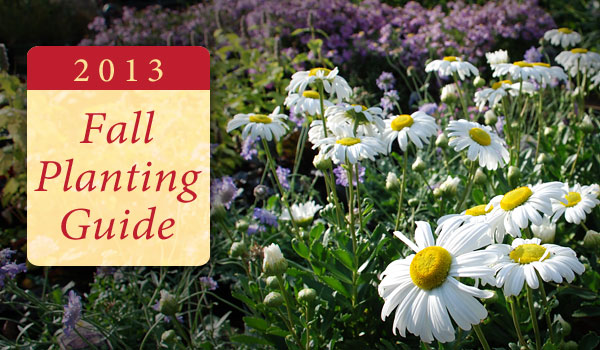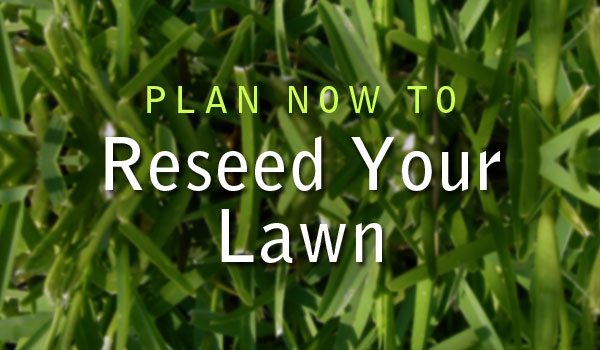Time to Plant Bulbs
Cary, NC — Bulbs are like magic. You put them in the ground now and they produce masses of flowers for years to come. Read more
Cary, NC — Bulbs are like magic. You put them in the ground now and they produce masses of flowers for years to come. Read more
Cary, NC — So easy, so colorful, nothing says autumn like mums. When it comes to flowers in the fall, Chrysanthemum rules the garden. Read more
Cary NC – In Part 2 of our Fall Planting Guide, we’ll talk about trees, shrubs and ground covers – the ceiling, walls and floor of your garden.
In Part 1, we talked about Annual Flowers, Perennial Flowers, Flowers for Spring as well as Fall Vegetables.
But a balanced garden also has an assortment of shrubs, trees and ground cover plants. Starting now is the perfect time to plant a few of these foundational elements.
The weather continues to be mostly on the cool side for this time of year. The rain has backed off a bit so you might be watering now and then when it’s your day in Cary (Odd: T, Th, Sa; Even: W, F, Su).
Average time for fall planting in Piedmont region of North Carolina is mid-September. But this year, the ground is relatively cool and you can start planting now over the long Labor Day weekend.
Shrubs are a medium sized element in the garden. They are useful to give height to a bed and to surround structures like a house or a deck.
Some shrubs are evergreen, others die back in the winter (deciduous). They can be loose or tight, add a spark of color in summer or a bit of green in winter.
Very useful, shrubs. Don’t get as much attention from gardeners as flowers and trees. Shrubs might be the Rodney Dangerfield of the plant world.
Here are a few of my favorite shrubs for your Cary garden with some notes about how to use them. Put a couple on your fall planting list.
Azalea – The Queen of Southern shrubs. Unmatched blooms in Spring create a wall of color. Likes shade and some moisture. Evergreen.
Rosemary – Fragrant, evergreen, fine blue-green needles. The thing I like best about rosemary is that it can take a shearing. That is, you can prune it with an edge, shape it or even venture in simple topiary. Rosemary is very adaptable to sun or shade, prospers in low moisture and neglect. Perfect for my garden.
Butterfly Bush – A deciduous shrub, Butterfly Bush adds color in the height of summer through fall with loose, airy spikes of tiny flowers. Butterfly Bush is beloved of, yes, butterflies and insects of many types. A must for a free-flowing garden spot.
More shrubs – Boxwood and Privet are civilized, cooperative evergreen shrubs that are useful around decks and home foundations. Gardenia produces some of the most beautiful fragrance in the garden. Speaking of fragrance, don’t forget Roses, probably the world’s most popular shrub. Camelia is a true Southern favorite that blooms in early winter, a welcome occurrence in a bleak garden season.
All of the above can be planted starting now. The won’t look like much this fall, but good root growth over the fall and winter will set them up for a strong start next Spring.
Autumn is the season to plant trees in the South.
The most important thing to keep in mind is the placement of the tree and its eventual size. Don’t plant a really tall tree (like a White Oak) right next to your house.
Planting a tree is not hard. In fact, we made a video called “The Right Way to Plant a Tree.”
Here are a few favorite trees for the Cary homeowner’s garden.
Crepe Myrtle – You see Crepe Myrtles everywhere in Cary, and for good reason: they bloom all summer long. Small to medium tree, they love the weather in Cary. Love them back.
Purple Leaf Plum – Dark burgundy leaves make a welcome contrast from the dominance of green. Medium size tree, low maintenance.
White Oak – If you have a grove of trees, or a spot a little father from the house, consider a White Oak for your fall planting. Grows with a straight trunk, nice color in the fall, hangs onto its brown leaves until spring. One of the longest living of Eastern trees, that White Oak you plant this Labor Day weekend could be there when the U.S.A. celebrates it’s 500th birthday in 2376.
Dogwood – Beautiful flowers in spring (and the State Flower of North Carolina). Dogwoods are one of the few trees that thrives in shade. If you have a shady spot that needs some excitement, plant a neat row of Dogwoods.
Willow – Willow trees are good if you have a moist spot in your garden that’s too wet for other trees.
River Birch – River Birch also likes it moist. It can tolerate a fair amount of shade as well.
Thuja Giant – These trees are basically evergreen weeds. Perfect for dense screening, e.g from a road or a bothersome neighbor. Thuja Giants grow fast (very fast) and become a wide, thick, dense, tall impenetrable screen of green.
Now is the perfect time to plant some trees. Don’t forget to watch the video.
If shrubs are the Rodney Dangerfield of plants, ground covers are Cinderella. Totally forgotten. But ground covers are the secret to finish out your garden with a verdant floor, covering bare spaces and connecting the elements.
Creeping Juniper – Evergreen, slow growing, Creeping Juniper can take drought and neglect. Has an almost primeval look. Spreads along the ground with branches that root.
Liriope – Excellent for edging beds, Liriope has thick grass-like blades about 9-12 inches. Basically evergreen in North Carolina. Variegated Liriope is a nice variety with green and white striped leaves. Makes a neat and symmetrical cluster. Many varieties send up a nice purple spike of flowers in the Spring.
Ivy – Ivy comes in many varieties with big leaves, small leaves, dark greens, bright greens, yellows and whites. They cover the ground quickly and thrive in shade. But ivy will also cover your house if you let it. Every Spring (late winter, really), we cut back the ivy to keep it away from structures and trees we don’t want to destroy.
Sedge – Sedge is a grass that makes a nice border. It grows quickly and forms thick clumps. Thrives in sun or shade. Good beneath trees and in borders.
Black Mondo Grass – A real beauty in the garden, Black Mondo Grass rises about six inches above the ground with fine blades of purple-black grass. Grows slowly but easy to multiply by division. Fond of shadier spots.
There you have it – Fall Planting in Cary Parts 1 & 2.
Take advantage of the long planting season this year and put something in the ground this Labor Day Weekend.
——————————————————————————————————————–
Photo by CameliaTWU.
——————————————————————————————————————–
The Gardening Column on CaryCitizen is sponsored by Garden Supply Company on Old Apex Road in Cary.
 Cary, NC — We’ve made some adjustments to our Fall Planting Guide for 2013 to reflect the cooler, rainier weather we’ve had in Cary this year. Get out your gardening gloves for a compendium of flowers, vegetables, shrubs and ground covers for your Fall garden. Read more
Cary, NC — We’ve made some adjustments to our Fall Planting Guide for 2013 to reflect the cooler, rainier weather we’ve had in Cary this year. Get out your gardening gloves for a compendium of flowers, vegetables, shrubs and ground covers for your Fall garden. Read more
 Cary, NC – With all the wacky weather this spring and summer, it’s time to plan now to reseed your lawn this autumn. Read more
Cary, NC – With all the wacky weather this spring and summer, it’s time to plan now to reseed your lawn this autumn. Read more
Story by Lindsey Chester. Photo by Thomas Ormston.
Cary, NC – Spring planting season is almost to a close as the weather heats up in the Triangle. That said, it is an excellent time to take stock of your yard and current landscape and think about making some hardscape improvements. Read more
Story by Lindsey Chester. Photos by Lindsey Chester and Hal Goodtree.
Cary, NC – As we head into the summer months here in the Triangle, it is good to consider plants that like it hot and don’t need much water. These drought tolerant plants can keep your gardening lively during the hottest months of summer. Read more
Photo by Katja Schulz.
Cary, NC – As a transplant from New Jersey (relocated Yankee, anyone?), it has taken me a while (15 years and counting) to learn about the best plants for my Zone 7 yard. I’ve learned the hard way not to fight Mother Nature, but instead to embrace plants native to North Carolina. Read more
Story and photos by Hal Goodtree.
Cary, NC – On Monday, I had the pleasure of visiting the Culinary Farm at SAS Campus. This gem-of-a-garden supplies fresh vegetables and fruit for Herons, An and the SAS cafeterias.
I had heard about the farm at SAS a while back. Two years ago, the effort got a full-time Culinary farmer. Her name is Maggie Lawrence and she gave me the full tour on a bright morning.
“This is a culinary farm,” Maggie told me. “Everything we grow is for the table.” The farm supplies fresh-picked, organically grown vegetables and fruits to The Umstead Hotel, Herons and An Restaurant. The farm also supplies produce to the employee cafeterias at SAS and The Umstead.
“This is a late-spring garden,” Maggie told me. She’s growing broccoli, fennel, lots of lettuce, turnips, beets, peas and a whole lot more.
I saw cilantro blossoms and red vein sorrel; comfy, tarragon and chervil; opal basil and red Russian kale.
Maggie showed me red bok choi, Napa cabbage and rainbow chard. She has blueberry and blackberry shrubs just getting started with hopes to produce fruit in a couple of years. She even has a small stand of asparagus for future production.
The culinary farm also includes plants like Salvia and butterfly bush, grown not for the table but to attract pollinators like wild honey bees and butterflies.
Looking toward summer, Maggie plans to grown different varieties of tomatoes, cucumbers, carrots, peppers, sweet potatoes and other hot weather crops. She even grows produce for the Hotel bar, including mint and the aforementioned opal basil. “I’ve been consulting with a mixologist,” she explained.
The plot I saw was one of two on the SAS campus. Maggie and her co-worker Ariel Greenwood plant, pick and cultivate it all themselves.
As a guy who loves gardening, it was heaven. But all too soon, we all had to get back to work. Maybe I’ll get invited to visit again.
Story and photos by Hal Goodtree.
Cary, NC – The cool, damp weather that has settled on Cary this Spring continued for Herbfest 2013. But the chilly wind did not dampen spirits at Page-Walker for the most successful and interesting celebration of culinary gardening yet. Read more
